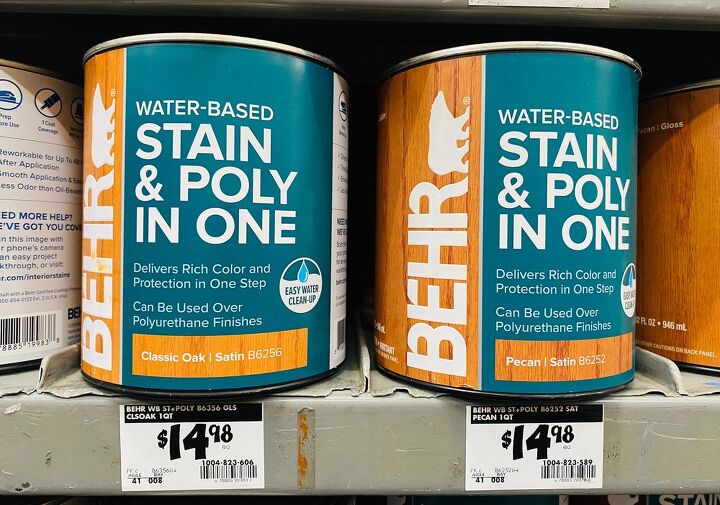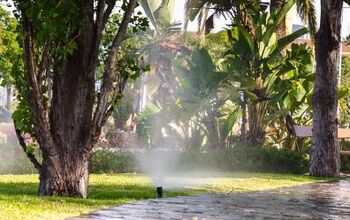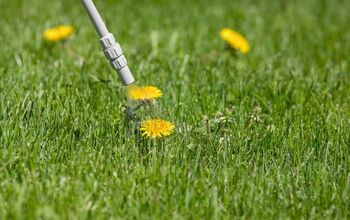8 Types Of Floor Finishes (With Photos)

Whether your goal is to protect your newly installed floors or you’re refinishing ones that are several years old, the first step is to choose the right topcoat. Regardless of the specific hardwood species, your floors need a finish coating to keep them looking their best and lasting as long as possible. With so many options, choosing the correct topcoat can be an overwhelming process.
Hardwood floor finishes come in varying levels of durability, sheen, and ease. The eight main types of floor finishes include water-based polyurethane, oil-based polyurethane, wax finishes, moisture-cured urethane, shellac, aluminum oxide, acid-cured finish, and penetrating oil sealer.
Not sure which hardwood floor finish to choose? Narrow down your decision by brushing up on the different types of floor finishes below, along with their associated pros and cons.
Do You Need to Hire a Flooring Contractor?
Get free, zero-commitment quotes from pro contractors near you.

1. Water-Based Polyurethane
Water-based polyurethane is one of the most popular floor finishes used in the home, and for good reason. Manufactured with synthetic plasticizers and resins, this type of finish is incredibly durable and resists moisture pretty well. With this finish, hardwood floors are easy to maintain. All you’ll need is a broom and damp mop, but leaks or spills should still be mopped up as soon as they’re discovered.
Additionally, water-based polyurethane is considered an environmentally friendly choice, as it releases less volatile organic compounds (VOCs) than most other options. It also has an almost undetectable odor during application and dries fast. You’ll only have to wait about two to four hours between coats, with three to four total coats being the recommended amount.
Pros of water-based polyurethane
- Low VOC content and minimal odor.
- Easy application and cleanup with soap and water.
- Comes in different sheens: high gloss, low gloss, and matte.
- Fast-drying – can walk on the floors as early as the following day.
- Tough and scratch-resistant.
- Goes on clear, with no yellowing.
- Easy maintenance.
Cons of water-based polyurethane
- Cannot be waxed, as it will dull the finish.
- High-gloss versions magnify scrapes and scratches.
- High-traffic or damaged areas cannot be touched up. They must be re-sanded and the entire floor must be refinished.
2. Oil-Based Polyurethane
Oil-based polyurethane is made up of linseed oil, synthetic resins, and plasticizers. Because of its durability and strength, this finish is popular among old-school tradesmen and for commercial properties. Many homeowners choose to opt for oil-based polyurethane finish for high-traffic areas of their home.
This finish releases high levels of VOCs, has a strong odor, and dries as a slight amber color. It can yellow over time, which adds a lovely, rich, amber color to your flooring. Though, if this is not a goal, you’ll want to opt for a different finish. Cleanup is a little more difficult with oil-based polyurethane, as mineral spirits must be used. The coats also take longer to dry – usually 10 hours for each coat, with two to three recommended in total.
Pros of oil-based polyurethane
- Available in high-gloss, semi-gloss, and satin sheens.
- Relatively affordable.
- Easy to maintain – only regular cleaning required.
- Surface not prone to scratching.
- Resistant to moisture.
Cons of oil-based polyurethane
- Has an amber, yellowish color.
- Strong odor and high VOC content.
- Dries slower than water-based polyurethane.
- Like water-based polyurethane, you cannot touch up this finish – you must refinish the whole floor.
3. Wax Finishes
Before polyurethane finishers hit the market in the 60s, wax was the floor finish of choice for centuries. Today, it is still a popular choice for historic homes and preferred among do-it-yourselfers looking for a natural, low-sheen look. Wax comes in two forms: liquid and paste. Both require several coats that must be buffed by hand, but paste wax is applied with a rang and liquid wax is typically applied with a wool applicator.
However, using wax has a hardwood floor finish does not yield a durable finish. Water can create white marks in the floor and scratching and scuffing is common. As such, wax is not ideal for kitchens or bathrooms. Wax can also yellow or darken over time, so it should be used with a wood that already has a warm cast.
Pros of wax finishes
- Low odor and low VOC content.
- Easy application and touch-ups.
- Enhances natural color and grain of wood.
- Dries quickly.
Cons of wax finishes
- Labor-intensive application – needs multiple coats to create depth.
- Darkens and yellows over time.
- High-maintenance – requires frequent recoating and buffing.
- Not very durable, scratch-resistant, or water-resistant.
4. Moisture-Cure Urethane
For applications that require the toughest floor finish, moisture-cure urethane is the best choice. It was originally designed to be used in bowling alleys, making it an incredibly tough, durable, and high-shine finish. Moisture-cure urethane also resists general wear, scratches, stains, and moisture.
Though, since it is difficult to apply, this finish may not be an option for DIYers. Not to mention, the incredibly high level of VOCs can linger in your home for weeks on end, causing household members to relocate for up to two weeks after application. As the name suggests, this finish takes moisture from the air to cure and is affected by humidity on the day of application.
Due to the numerous drawbacks, moisture-cure urethane is most commonly used for commercial applications such as restaurants, dance halls, and bowling alleys. These are all locations that need their floors to be very strong, have a high-gloss look, and resist moisture and wear.
Pros of moisture-cure urethane
- Incredibly durable.
- Resistant to scratches, moisture, stains, and wear.
- Ideal for commercial settings
Cons of moisture-cure urethane
- Difficult to apply – not ideal for DIYers.
- High VOC content.
5. Shellac
For those who desire a natural product that dries quickly and has a low VOC content, shellac is the ideal choice. Used for hundreds of years, this finish is made from denatured alcohol and combined with secretions of the lac bug. Shellac dries quickly to have a natural orange tint and a high-gloss finish. However, it can be tinted, bleached, or mixed with additional denatured alcohol to yield a more matte look.
This finish is prone to staining, getting water spots, and is vulnerable to both ammonia and alcohol. While shellac doesn’t withstand foot traffic as well as polyurethane, it can be easily touched up by buffing in a new coat as needed.
Pros of shellac finish
- A natural, eco-friendly choice.
- Easy to touch up and repair.
- Dries fast.
- Adheres easily to oily tropical woods.
Cons of shellac finish
- Flammable.
- Can be difficult to apply evenly.
- Less durable than alternative options.
- Must be freshly mixed immediately prior to application.
6. Aluminum Oxide
Aluminum oxide is a naturally occurring mineral, ideal for high-traffic areas or anywhere where a long-lasting, durable coating is desired. This finish protects the floor from water damage, facing, scuffs, scratches, and general wear and tear without altering the color of the wood or concealing the grain. It comes in varying levels of sheen, and can be as shiny or matte as you prefer.
Though, this floor finish is only available for prefinished flooring planks and cannot be applied as a DIY project. If you eventually need to touch up damage or would like to swap out for a different finish, aluminum oxide is very difficult to remove or restore. However, if you want the most durable finish – lasting up to 25 years – aluminum oxides is the way to go.
Pros of aluminum oxide
- The most durable and long-lasting floor finish available.
- Low-maintenance.
- Comes in varying levels of shine.
Cons of aluminum oxide
- Hard to touch up or refinish.
- Can only be found on prefinished planks.
7. Acid-Cured Finish
Also referred to as conversion or Swedish finish, acid-cured finish is extremely durable. It is commonly used for exotic wood floors or those that have intricate patterns. The product has an alcohol base and, as the name suggests, uses acid for curing. Acid-cured finish creates a shiny finish that is durable, and resistant to scuffs, scratches and chemicals, while highlight the grain, natural beauty, and color of the wood.
The drawback to this finish is that it releases very high levels of VOCs has a strong odor. If you choose to apply it, you must have proper ventilation, a full-face respirator, and ensure that your family and pets stay away for several days.
Pros of acid-cured finish
- Dries quickly.
- Exceptionally durable.
Cons of acid-cured finish
- Highly flammable.
- Expensive product.
- Very high levels of VOCs and strong odor.
- Should only be applied by professionals.
Do You Need to Hire a Flooring Contractor?
Get free, zero-commitment quotes from pro contractors near you.

8. Penetrating Oil Sealer
Penetrating oil sealers were a popular option prior to the creation of polyurethane sealers. While they aren’t used as much today, they are still favored by some homeowners who desire a finish that brings out the natural depth, beauty, and grain of the wood without adding any gloss. There are several different types of penetrating oils, with tung oil being the most common.
This finish soaks deep into the pores of the wood to prevent damage, all without creating a hard “shell” on top. For this reason, wax is often used as a final coat to add more protection to the floor. Although penetrating oil sealers will create a lovely natural look, they don’t withstand foot traffic well. In fact, you’ll likely have to refinish your floors every three to five years with this finish.
Pros of penetrating oil sealer
- Yields a low-shine finish, while highlighting the natural characteristics of the wood.
- Natural, eco-friendly product.
- Easy to apply.
Cons of penetrating oil sealer
- Not very durable.
- Expensive.
- Must be recoated every few years.

Jessica considers herself a home improvement and design enthusiast. She grew up surrounded by constant home improvement projects and owes most of what she knows to helping her dad renovate her childhood home. Being a Los Angeles resident, Jessica spends a lot of her time looking for her next DIY project and sharing her love for home design.
More by Jessica Stone


































